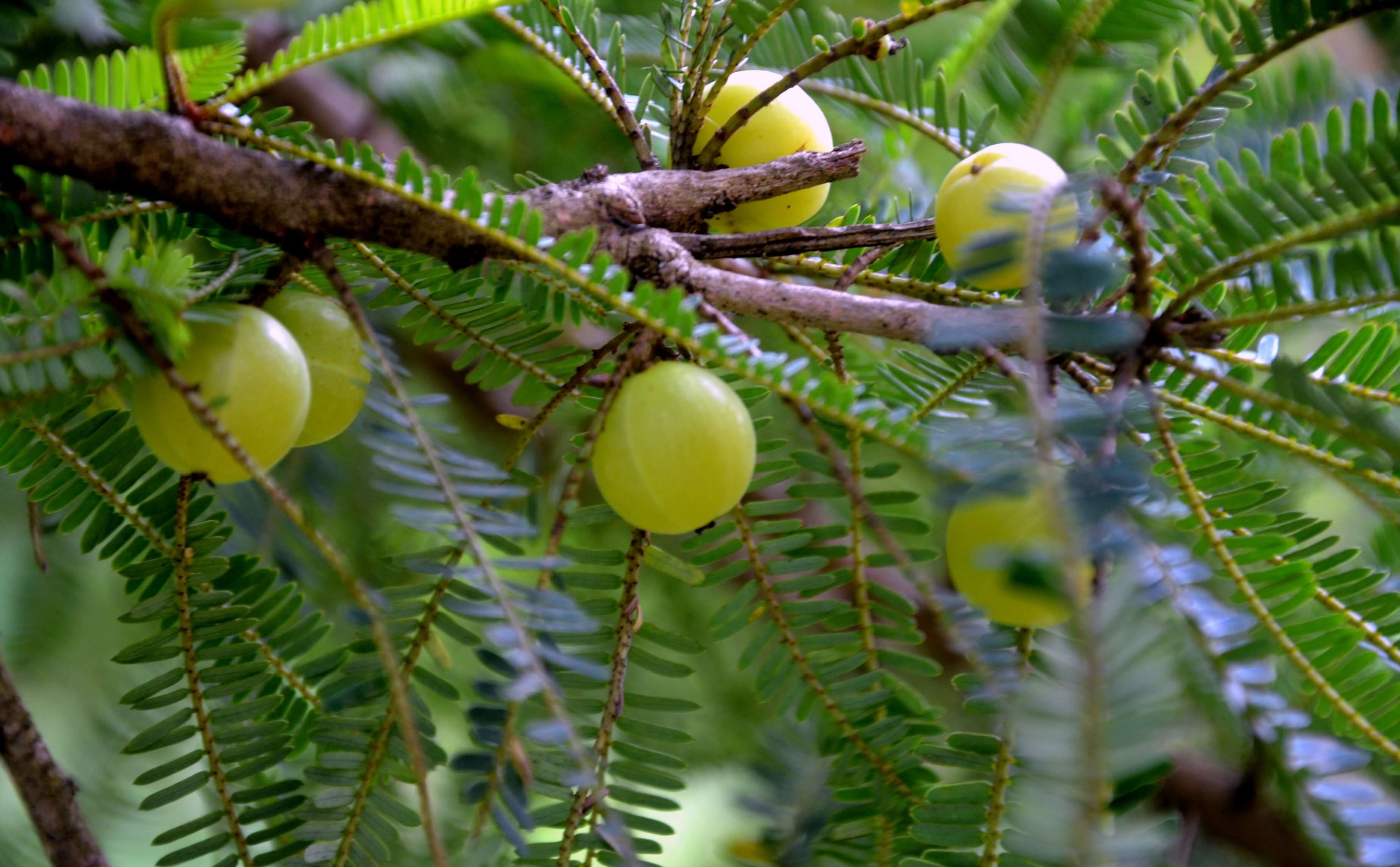
ශාක කුලය - යුපේබියාසේ - Euphorbiaceae
සිංහලයන් නෙල්ලි යනුවෙන් භාවිත කරනු ලබන මෙම පලතුරු වර්ගය ශරීරයට ඉතාමත් ගුණදායක අත්දුටු ඔසුවකි. ශරීරයේ උෂ්ණය සමනය කරන වා, පිත්, සෙම් සමනය කර සිරුරට සහනය ගෙන දෙන නෙල්ලි ජීවක ඔසුවක් ලෙස සඳහන් වේ. එසේ ම රූපලාවන්ය කටයුතුවල දී ද නෙල්ලි ගෙඩි යුෂ ඉතා වැදගත් වේ. නෙල්ලි ගෙඩියේ රස පහක් ඇති බව ආයුර්වේද මතයයි. එම රස පහ මෙසේ දැක්වේ. කහට, තිත්ත, කටුක, ඇඹුල්, පැණි රස. මේ රස පහ නෙල්ලි ගෙඩියක් විකන ඔබට දැනෙනු ඇත. ඇතැම් අය නෙල්ලි නිතර කෑමට ප්රිය කරන අතර එය අගුණ නොවේ.
චෛත්ය ඉදිකිරිමේ දී "ආමලලාකාර" යනුවෙන් නම් කර ඇත්තේ ද නෙල්ලි ගෙඩියේ හැඩයයි. මේ කියන නෙල්ලිවලට විශේෂ තැනක් හිමි වන බව කිව යුතු ය. අමුවෙන් පලතුරක් වශයෙනුත් වේළාගත් කල කෂාය වට්ටෝරුවටත් එය පදම් කර කල්ක වශයෙන් සාදා ගුළි ලෙසින් ගිලීමටත් ගනු ලබයි. පලතුරක් ලෙසින් නෙල්ලිවලට ඇත්තේ විශාල ඉල්ලුමකි. එයට හේතුව රූපාලංකාරය ඇති කරන ශරීරයේ සම මෘදු කරන ගුණයෙන් නෙල්ලි සාරවත් වීමයි. සිංහලයන් නෙල්ලි යනුවෙන් හඳුන්වන මෙම ශාකය සංස්කෘත වේද ග්රන්ථවල දැක්වෙන්නේ අම්ලිකා, පඤ්චරසා ධාත්රී, අමෘතා, ඍතුවර්ධනී ආදී වශයෙනි. දෙමළ භාෂාවෙන් නෙල්ලිකා යනුවෙන් ද ඉංග්රීසි බසින් මයිරෝබලන් ලෙස ද නෙල්ලි හඳුන්වනු ලබයි. නෙල්ලි ගසේ ජන්ම භූමිය කිනම් පෙදෙසක් ද යන්න නිගමනය කර නැතත් නෙල්ලි ශාකය බොහෝ සේ ව්යාප්ත ව ඇත්තේ හිමාලයා පෙදෙසේ ය. ඉන්දියාව නෙල්ලි වගාවක් ලෙසින් ව්යාප්ත කර ඇති අතර අපේ රටට බෙහෙත් වශයෙන් නෙල්ලි ගෙන්වන්නේ ඉන්දියාවෙනි.
නෙල්ලි ගසක් සාමාන්යයෙන් මීටර් 15ක් තරම් උසට වැඩේ. ව්යාප්තිය සිදුවන්නේ නෙල්ලි බීජවලින් පමණි. නෙල්ලි ගෙඩියේ පොත්ත හෙවත් රස කොටස ඉවත් කළ විට ඇටය හමුවේ. මේ ඇටය ඉතාමත් ශක්තිමත් ඝන ව්යුහයකින් ආරක්ෂා වී ඇත. මුහුදු මට්ටමේ සිට මීටර් 1200ක් තරම් වූ උෂ්ණ වියළි දේශගුණය ඇති ප්රදේශ මෙම ශාකයට ඉතා හිතකර ය. නෙල්ලි ගසේ පත්රිකා ඉතාමත් කුඩා ය. කුඩා පත්රිකා දහස් ගණනින් අතු රිකිලි ගැවසී සිටී. මෙම පත්රිකාවක් සියඹලා පත්රිකාවටත් වඩා කුඩා ය. මේ කුඩා පත්රිකා සියයක් පමණ එක් අතු රිකිල්ලක දෙපේළියට විහිදී ඇත. නෙල්ලි ගෙඩි හටගන්නේ මේ අතු නාරටිවල යටි පැත්තේ ය.
මල් කිනිති ලෙස හටගනී. වර්ෂයේ ඔක්තෝබර් හා නොවැම්බර් මාසවල මෙම ගෙඩි හටගැනීම සිදු වේ. කුඩා නෙල්ලි මලක පෙති හයක් ඇත. එහි රේණු හයක් කුඩාවට පිහිටා ඇත. නෙල්ලි බොහෝ සේ ඵල හටගන්නා ශාක විශේෂයකි. එහෙත් සමහර ගස්වල මල් පමණක් හටගනී. ගෙඩි හටගන්නේ නැත. නෙල්ලි ගෙඩිය වටකුරු ය.
නෙල්ලි ගෙඩියක් සාමාන්ය සිංහල එළබටු ගෙඩියක් තරම් වේ. මෙම ගෙඩිය පළු හයක් වශයෙන් ඇත. බාහිර ව ඇති පොත්ත හෙවත් කෑමට ගන්නා මාංශල කොටස 8 mmක් 10ක් තරම් වේ. බීජය කොළ පැහැයෙන් යුක්ත ය. එය පළු හයක් වශයෙන් බෙදී ඇත. මෙය පළා බැලූ විට මුං ඇටයක් තරම් වූ නෙල්ලි බීජය ඇතුළේ දැකගත හැකි ය. නෙල්ලි ගසේ ඝනකම් පොත්තක් ඇත. එය මතුපිට අළු පැහැයත් ඇතුළත කහට මුසු රත් පැහැයත් ඇත.
ප්රයෝජන
නෙල්ලි ගෙඩි වටිනා බෙහෙත් ඖෂධයකි. වාජීකරණ ගුණදායක ඖෂධයක් ලෙස ආයුර්වේදයේ සඳහන් වේ. එසේ ම වස විස නැති ගුණදායක පලතුරකි. තුන්දොස් සමනයට නෙල්ලි ඉතා යෝග්ය ය. මුත්රා දැවිල්ල ඇති විට නෙල්ලි දමා සාදාගත් වතුර පානය යෝග්ය ය. වියළි නෙල්ලි ස්වල්පයක් ඇල්වතුර වීදුරුවකට දමා උදේට එම නෙල්ලි වතුර පෙරා සීනි මුසු කර බීමෙන් ඇග නිවේ. එය ආයුර්වේද නියමයකි.
Type of Genus - Euphorbiaceae
Known as Nelli to the Sinhalese, this fruit is a very healthy herbal remedy. Nellie is said to be a living
medicine that soothes body heat, soothes pits and skin and brings relief to the body. Nellie juice is also
very important in cosmetics. Ayurveda says that Nellie fruit has five or the six flavors. The five flavors
are as follows. Sweet, Sour, Bitter, Pungent and Astringent.
The shape of the Nellie fruit is also known as "Amalalakara" in the construction of the dagoba. It must
be said that these Nellies have a special place. As a raw fruit, it is dried and mixed into a decoction by
boiling and then ground into a paste and swallowed. Nellie is in great demand as a fruit. The reason for
this is that Nellie is rich in the skin softening properties of the body that can be used to restore
youthfulness. The Sinhalese call this plant Nelli and it is mentioned in Sanskrit Vedic texts as Amlika,
Pancharasa Dhathari, Amrita, Rituwardhani etc. Nelli is also known as Nellika in Tamil and Myrobalan
in English. Although the birthplace of the Nellie tree has not been determined, the Nellie plant is most
widespread in the Himalayas. India has expanded as a Nellie growing country and Nellie is imported
from India as a medicine for our country.
Nellie tree usually grows to a height of 15 meters. Propagation occurs only by Nellie seeds. When the
bark or flavor of the nelly fruit is removed, the seed is found. This seed is protected by a very strong
solid structure. Areas with hot dry climates up to 1200 m above sea level are very favorable for this
plant. The leaflets of the Nellie tree are very small. Thousands of small leaflets line the branches. This
leaflet is even smaller than the Siyambala leaflet. About 100 of these small leaflets are spread in two
rows on one branch. Nellie fruits on the underside of these branches.
Fruiting occurs in October and November of the year. A small nelly flower has six petals. Its six stems
are small. Nellie is a fruit bearing plant. But some trees only flower. Fruits do not form. Nellie nut is
round.
Nellie nut is about the size of a normal vegetable. The outer bark is about 8 mm by 10 mm. The seed is
green. It is divided into six pieces. This can be seen inside the nelly seed which is about the size of a
green gram when it escapes. The nelly tree has a thick bark. It is gray on the surface and red on the
inside.
Nellie is a valuable medicinal plant. It is mentioned in Ayurveda as a medicine. It is also a nonpoisonous,
nutritious fruit. When there is inflammation of the urethra, it is advisable to drink a
concoction made from Nellie. Put some dried Nellie in a glass of water, filter the Nellie water in the
morning, mix it with sugar and drink it. It is an Ayurvedic prescription.